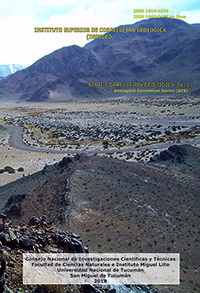Serie Correlación Geológica 34 (1)
Structural variation of the masseter muscle in Typotheria (Mammalia, Notoungulata)
Luis Marcelo Sosa | Daniel Alfredo García López
Descargar trabajo en formato PDFResumen
VARIACIÓN ESTRUCTURAL DEL MÚSCULO MASETERO EN TYPOTHERIA (MAMMALIA, NOTOUNGULATA). La gran diversidad morfológica del orden Notoungulata se expresa en rasgos notorios, como el tamaño corporal, incluyéndose aquí desde animales del porte de un pequeño roedor (e.g., Punapithecus) hasta formas de más de una tonelada (e.g., Trigodon). Se conocen además, diferentes casos de convergencia con otros placentarios, reconociéndose formas rodentiformes y otras similares a lagomorfos, perisodáctilos y artiodáctilos. Esta notable diversidad se expresa también en rasgos específicos, como la región auditiva y el aparato masticatorio. En este trabajo se presenta un análisis sobre la evolución estructural de la zona de origen del músculo masetero enfocada en el suborden Typotheria. Se seleccionó una muestra de 12 representantes de ese grupo más dos representantes de notoungulados tempranamente divergentes (Henricosborniidae y Notostylopidae). La muestra abarca un lapso de más de 43 Ma (Eoceno–Pleistoceno). Se establecieron tres condiciones principales relacionadas con el origen del masetero que muestran cierto ordenamiento temporal y filogenético. La Condición 0 (e.g., Colbertia, Oldfieldthomasia) se caracteriza por el origen puntual y restringido del masetero superficial y por una zona limitada para el masetero profundo, encontrándose exclusivamente en formas eocenas y siendo comparable al plan generalizado presente en ciertos marsupiales (e.g., Didelphis). La Condición 1 (e.g., Notopithecus, Protypotherium) presenta un masetero profundo de desarrollo limitado y un masetero superficial asociado a un proceso descendente conspicuo, mostrando similitudes con Lagomorpha (e.g., Oryctolagus). Finalmente, la Condición 2 (e.g., Griphotherion, Typotheriodon, Hegetotherium, Paedotherium) es la más compleja, mostrando un espectro de variaciones relacionadas con diferentes grados de hipertrofia del masetero profundo y reflejando similitudes a nivel superficial con ciertos roedores (e.g., Sciuromorpha). Esta perspectiva más focalizada muestra la complejidad alcanzada por los Notoungulata y es necesaria para obtener un cuadro más completo de la evolución del grupo, el cual brinda la oportunidad de estudiar la historia natural de un linaje de raíz mesozoica, sometido a aislamiento geográfico y sobreviviente casi hasta tiempos recientes.
Abstract
The great morphologic diversity of the order Notoungulata is evident in remarkable traits, such as the body size, and this group includes from small, rodent size animals (e.g., Punapithecus) to forms exceeding 1000 kg in weight (e.g., Trigodon). Moreover, several cases of convergence with other placentals are known within the group, with rodent-like and lagomorphs-like forms in Typotheria and animals similar to some Perissodactyla or Artiodactyla within Toxodontia. This remarkable diversity is also expressed in specific traits developed on certain parts of the skeleton, such as the auditory region or the masticatory apparatus. In this contribution we present an analysis on the structural evolution of the area of origin of the masseter muscle focused on the suborder Typotheria. A sample of 12 representatives of that group was selected, plus two representatives of early diverging notoungulates (Henricosborniidae and Notostylopidae). This sample covers a span of approximately 43 Ma (Eocene –Pleistocene). On each case, the relative development and arrangement of the different parts of the masseter was determined evaluating the area of the muscular scars remaining on the zygomatic arch and its anterior root. Three main conditions related to the origin of the masseter muscle were deduced, showing some temporal and phylogenetic arrangement. Condition 0 (e.g., Colbertia, Oldfieldthomasia) is characterized by a small origin of the superficial master and a small area for the deep master, is only present in Eocene representatives, and is comparable to the generalized plan present in some marsupials (e.g., Didelphis). Condition 1 (e.g., Notopithecus, Protypotherium) presents a moderately-developed deep master and an origin of the superficial masseter related to a conspicuous descendant process, being similar to some Lagomorpha (e.g., Oryctolagus). Finally, the condition 2 (e.g., riphotherion, Typotheriodon, Hegetotherium, Paedotherium) is the most complex, showing a spectrum of variations related to different stages of hypertrophy of the deep masseter which reflex similarities to certain rodents (e.g., Sciuromorpha). This morphologic perspective shows the complexity achieved by the Notoungulata and brings a more complete frame on the evolution of this group, which represents one of the most characteristic elements of the South American fossil biota.






